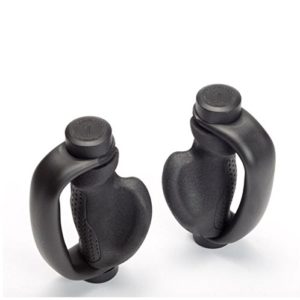Weighted gloves may alleviate bone mineral redistribution
THE CAPITAL TIMES, Tuesday, April 3,1984
Are “Heavyhands” weights and weighted fitness gloves gimmicks?
Or will they prevent runners from behaving like mule deer?
Researchers discovered in 1973 that something odd occurred in mule deer when they developed antlers.
Bone mineral was lost from unstressed areas of the deer, such as the ribs, and redistributed to the growing antlers.
Ten years went by before the significance of the bone mineral redistribution phenomenon really became clear. Its importance emerged in research by Dr. Everett L.
Smith, director of the University of Wisconsin Biogerontology Laboratory.
Smith was studying osteoporosis, the loss of bone mass during aging. Osteoporosis is a major problem for older women, who suffer fractures as their bones become more and more brittle.
The impact of exercise on bone, which behaves much like muscle when placed under stress, was already known.
Studies showed distance runners had 20 percent more bone mineral content in their femurs than on-runners.
Professional tennis players were found to have thicker humeral bones in their playing arm – 35 percent for men and 28 percent for woman – than in their non-playing arm.
At the same time, studies of astronauts showed they lost 7 percent of their heel bones during only 10 days of weightlessness in space. People on bedrest for 36 weeks showed a loss of 39 percent of their bone mineral content.
Smith studied groups of women ages 35 to 95. His studies showed that a combination of exercise (aerobic dance) and good diet (with adequate calcium and vitamin D) reversed the women’s loss of bone mass, which normally accelerates after menopause.
In one three-year study, the control group lost 3.29 percent of their bone mineral content while subjects on a calcium-vitamin D supplement gained 1.58 percent and those on an exercise program gained 2.29 percent.
In another three-year study, the control group lost bone mass at a rate of 2.44 percent, while an exercise group gained 1.39 percent.
The gain was not constant, however.
Smith, who was using a device that measured bones in the arm to gauge mineral content of the subjects, found the exercise group experienced a drop in bone mass the first year before scoring gains in the second and third years.
The unexpected initial decline was eventually determined to be due to the calcium redistribution mechanism like that found in mule deer.
Women placed on an aerobic dance program stressed their legs, for which calcium was taken from unstressed areas like the arms.
The femur thickened, while the ulna and humerus initially weakened.
Smith said the skeletal system behaves like the muscular system. Both adapt to the stresses placed upon the body.
“If you don’t use the human body, not only do you waste muscle mass and the heart, but you also lose bone,” Smith said.
Osteoporosis is mainly a problem for women, who lose 30 percent of their bone between the ages of 30 and 70.
Men start the aging process with about 40 percent more bone mass, lose it at a slower rate and usually don’t have a problem with weak bones until their mid-80s.
With aging women suffering 150,000 to 200,000 broken hips a year in the United States, getting them to exercise could have a big impact on health care costs.
Smith estimates the bill for their hospital care alone is about $1 billion and, when nursing home care and other costs are added, the total price tag for osteoporosis is about $3 billion a year.
What the calcium redistribution effect indicates, however, is that aerobic exercise like dance or running is not enough.
Weights are also needed to maintain the upper body and Smith now recommends a routine that includes use of wrist or hand-held weights and pulling on surgical tubing attached to a post or wall to prevent redistribution.
The evidence seems to support the “Heavyhands” devices and weighted gloves sold for running.
If you don’t have time to get in upper body workouts separately, they are probably the way to go.
End.
Thankfully entrepreneur Michael Senoff of www.WeightedHands.com began producing replacement weights and also specialized ergonomic handles for “HeavyHands” exercise, the prospects for finding new equipment were virtually nill.
Now, thanks to Senoff, the HeavyHands enthusiast can progress from the smallest weights used at the beginning to the heavier weights required for maximum strength endurance development.
Finally, people are able to progress as far as they want using HeavyHands.
Once again, Dr. Schwartz’ proven methods are helping a new generation of exercise and weight loss enthusiasts.







Recent Comments